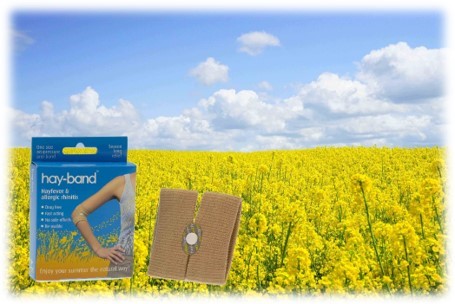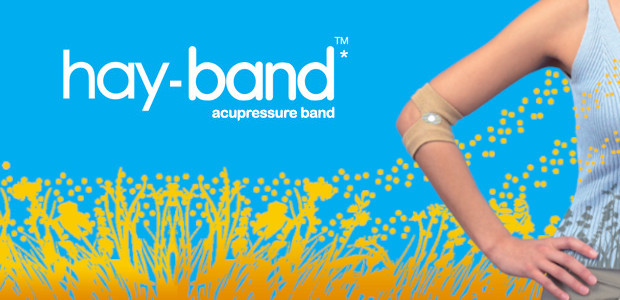Stay one step ahead of hay fever with the hay-band
Affected by hay fever? Apply some pressure. The principles of ancient Chinese acupressure have been used for centuries to help treat the symptoms of allergy, including hay fever.

hay-band works by applying pressure to the acupressure point on either arm, called the LI-11 point.
Acupressure is believed to increase the flow of natural energy through the stimulation of various pressure points and in doing so, help unblock energy pathways to the nose and throat, and promote wellbeing.
The LI-11 point can be found at the end of the crease at the elbow. Once located, simply slide a hay-band into position so that the button faces inwards over the pressure point, with the bands passing either side of the elbow.
The band is fast-acting and may be worn on either arm or if symptoms are acute, one can be worn on both arms. Drug-free, natural and discreet, hay-band can also be worn as a preventative.
There is no drowsiness or other unwanted side-effects and the band is suitable for adults and children over the age of three, but not suitable for use during pregnancy.
hay-band costs £11.99 per (washable) band and is available online from hay-band.co.uk.
3 ways to keep hay fever at bay
1) Stay one step ahead
A bit of detective work will help keep you one step ahead of your pollen-shaped foe: check prevailing winds and pollen counts and limit outdoor activity during the early morning hours, when pollen counts tend to peak.
2) Apply some pressure
The principles of ancient Chinese acupressure have been used for centuries to help treat the symptoms of allergy, including hay fever. hay-band works by applying pressure to the acupressure point on either arm, called the LI-11 point (£11.99, from hay-band.co.uk).
3) Treat yourself to some sweet stuff
Although it’s not a solution that works for everyone, many people believe that local honey has an anti-histamine effect, the theory being, the pollen that is naturally present can have a desensitising effect.
DID YOU KNOW? HAY FEVER FACT FILE
• It is estimated that 20% of people in the UK are affected by hay fever with grass pollen being by far the biggest trigger.
• Pollen causes cells to release histamine and other chemicals, resulting in a runny, itchy nose, blocked sinuses, sneezing, redness and watering of the eyes, and/or a sore, itchy throat.
• Where you live in the country can determine when you’re likely to be affected. Generally there’s a later start and shorter season in the north of the country, where there tends to be less pollen. Urban areas also have lower counts than the countryside, but arguably other airborne irritants to contend with.
• If you are prone to hay fever the following precautions may help to keep your symptoms to a minimum: keep your body as free from toxins as possible by eating wholefoods and avoiding junk; keep your caffeine and alcohol intake low and avoid nicotine; reduce the toxic load on your system by drinking plenty of water and keeping your bowel moving daily.
• Many people with hay fever are also likely to have sensitivity to certain foods, including dairy. Dairy foods are mucous-forming which can make hay fever symptoms worse. Try to keep dairy produce to a minimum or seek out dairy-free alternatives such as rice or oat milk.
• Check prevailing winds and pollen counts and remember that wind dried clothes can become pollen catchers. Hanging clothes inside will keep them pollen free.
• Some people believe that local honey has an anti-histamine effect. Although it’s not a solution that works for everyone, the pollen that is naturally present in the honey is thought to have a desensitising effect.
• Don’t be an early bird! Getting up early can make your symptoms worse as pollen counts tend to peak between 5am and 10am.









